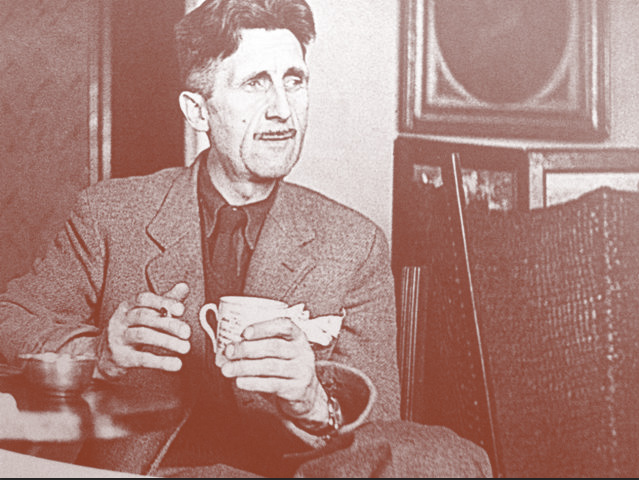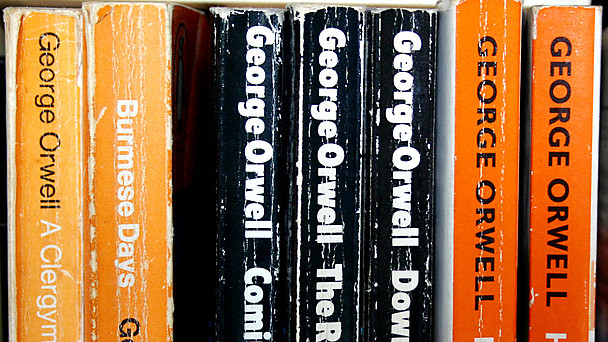
Photo credit: Ink Tank
A slow news day
On 12 January 1946, World War II having ended and it being a slow news day, London’s Evening Standard published an essay by George Orwell titled ‘A Nice Cup of Tea’.
If you look up ‘tea’ in the first cookery book that comes to hand you will probably find that it is unmentioned; or at most you will find a few lines of sketchy instructions which give no ruling on several of the most important points.
This is curious, not only because tea is one of the main stays of civilisation in this country, as well as in Eire, Australia and New Zealand, but because the best manner of making it is the subject of violent disputes.
Well someone has his mid-1940s white man’s lens on. If the Allies hadn’t so roundly defeated Japan they might have discovered that tea was, in fact, a very important component of cooking and actually there were many cookery books on tea—perhaps lost in the war. Many would’ve been written in Chinese or Japanese, er herm.
Besides which, George*, you don’t ruddy well find instructions on how to make tea in a cookery book (… unless that cookery book is the instruction manual for a tea processing organisation). Cookery books are for apricot chicken and banana cake and cookbook authors want no part in the subjective ‘violent disputes’ of which you write.
‘Golden’ rules
When I look through my own recipe for the perfect cup of tea, I find no fewer than eleven outstanding points. On perhaps two of them there would be pretty general agreement, but at least four others are acutely controversial. Here are my own eleven rules, every one of which I regard as golden:
First of all, one should use Indian or Ceylonese tea. China tea has virtues which are not to be despised nowadays — it is economical, and one can drink it without milk — but there is not much stimulation in it. One does not feel wiser, braver or more optimistic after drinking it. Anyone who has used that comforting phrase ‘a nice cup of tea’ invariably means Indian tea.
Foul: subjective! Indian and Sri Lankan tea is indeed robust, but Orwell’s claim about Chinese tea—”there is not much stimulation in it”—simply reeks of a small sample size. Had Orwell actually tried good quality Chinese tea? As for “one does not feel wiser, braver or more optimistic” after drinking Chinese tea, he clearly forgot about all the Taoists and Zen Buddhists who certainly drank tea to feel that way.
I also take exception to the blanket statement: “Anyone who has used that comforting phrase ‘a nice cup of tea’ invariably means Indian tea.” ‘Invariably’? I do not think ‘invariably’ means what you think it means. Here’s a statement I will make to unravel that statement: “I will have a nice cup of Taiwanese oolong tea.”
Call yourself a writer…

Photo credit: Pixgood
Secondly, tea should be made in small quantities — that is, in a teapot. Tea out of an urn is always tasteless, while army tea, made in a cauldron, tastes of grease and whitewash. The teapot should be made of china or earthenware. Silver or Britanniaware teapots produce inferior tea and enamel pots are worse; though curiously enough a pewter teapot (a rarity nowadays) is not so bad.
Having never tasted ‘army tea’, I cannot vouch for Orwell’s description of it, but I can imagine it is probably true. His statement about making tea in small quantities is generally accepted, however. Some of the smallest usable teapots I’ve ever seen are probably only hold about 30ml. They are for special Chinese teas.
Metal containers such as silver and Britanniaware (a kind of pewter alternative), and nowadays stainless steel, affect the taste of tea by bringing out the tannins, which is why they are never going to give you the best brew. China, earthenware and, I will add, glass vessels are certainly better options. I’m guessing this is one of the points on which Orwell expects ‘general agreement’.
Thirdly, the pot should be warmed beforehand. This is better done by placing it on the hob than by the usual method of swilling it out with hot water.
Yes, yes warm pot, but I’m not turning on the stove as well as the kettle, George. Besides which, my most oft-used teapot, although glass on the inside, sits in a plastic cradle so you can’t subject it to direct heat. Methinks you haven’t seen far enough into the future to know this.
There’s no real difference between warming the pot via hob versus swilling hot water, save for the fact that the second way is faster and more energy efficient. Transfer of heat occurs faster via water than via a solid such as china and you can warm all the way to the top of a pot using hot water very quickly.
Fourthly, the tea should be strong. For a pot holding a quart, if you are going to fill it nearly to the brim, six heaped teaspoons would be about right. In a time of rationing, this is not an idea that can be realised on every day of the week, but I maintain that one strong cup of tea is better than twenty weak ones. All true tea lovers not only like their tea strong, but like it a little stronger with each year that passes — a fact which is recognised in the extra ration issued to old-age pensioners.
Meh. Depends on the tea and it depends on one’s personal taste. ‘Should be’ doesn’t belong here. Have an open mind, George. Maybe try a delicate jin jun mei?
Fifthly, the tea should be put straight into the pot. No strainers, muslin bags or other devices to imprison the tea. In some countries teapots are fitted with little dangling baskets under the spout to catch the stray leaves, which are supposed to be harmful. Actually one can swallow tea-leaves in considerable quantities without ill effect, and if the tea is not loose in the pot it never infuses properly.
Ideally, yes, tea should be free to move around in the pot. And people should also be free to choose if they would like to remove the leaves prior to partaking in this wonderful beverage. You can have both, it’s called an external strainer.
Sixthly, one should take the teapot to the kettle and not the other way about. The water should be actually boiling at the moment of impact, which means that one should keep it on the flame while one pours. Some people add that one should only use water that has been freshly brought to the boil, but I have never noticed that it makes any difference.
So single-minded! Boiling water suits some teas and not others. There’s no room for green or white or some oolong teas in George’s instructions; these types of tea don’t take high temperatures as well as his precious black Indian/Ceylon tea. Find the temperature that works best for your favourite teas.
He’s also wrong about the reboiling. Freshly heated water has more oxygen in it than reboiled water and oxygen helps the tea flavour emerge. I’m guessing if you always drink strong Indian/Ceylon tea, this might not make a noticeable difference, but for more fragrant and delicate teas it certainly does.
Seventhly, after making the tea, one should stir it, or better, give the pot a good shake, afterwards allowing the leaves to settle.
Optional. If you have enough tea in there this is not at all necessary. Orwell doesn’t explain why he suggests this.
Eighthly, one should drink out of a good breakfast cup — that is, the cylindrical type of cup, not the flat, shallow type. The breakfast cup holds more, and with the other kind one’s tea is always half cold before one has well started on it.
Well some people like a cup that cools the tea more quickly. Not everyone has asbestos mouth like you, George. Besides which, you’re forgetting about diversity in tea: the Chinese drink from smaller vessels refilled many times. Maybe you should think about the shape and material the cup is made from as well? Another suggestion: pre-warm the cup so it retains heat better, or better yet, get yourself an electric cup warmer. I’m guessing you didn’t have those back in 1946—shame, I think you would’ve made a great cup warmer advocate.

Russell Hobbs cup warmer || Photo credit: Cash Converters (more on this device in another post)
Ninthly, one should pour the cream off the milk before using it for tea. Milk that is too creamy always gives tea a sickly taste.
Or ignore this point completely if you don’t have milk with your tea.
Tenthly, one should pour tea into the cup first. This is one of the most controversial points of all; indeed in every family in Britain there are probably two schools of thought on the subject. The milk-first school can bring forward some fairly strong arguments, but I maintain that my own argument is unanswerable. This is that, by putting the tea in first and stirring as one pours, one can exactly regulate the amount of milk whereas one is liable to put in too much milk if one does it the other way round.
Yes, extremely controversial. Because science says you’re wrong. Putting the milk in after the tea denatures the proteins in the milk resulting in an uneven distribution and a “less pleasant taste”**. As for regulating the amount of milk, the practised tea-maker will already know how much to pour according to the strength of the brew and everyone else will just have to learn.
Or ignore this point completely if you don’t have milk with your tea.
Lastly, tea — unless one is drinking it in the Russian style — should be drunk without sugar. I know very well that I am in a minority here. But still, how can you call yourself a true tea lover if you destroy the flavour of your tea by putting sugar in it? It would be equally reasonable to put in pepper or salt. Tea is meant to be bitter, just as beer is meant to be bitter. If you sweeten it, you are no longer tasting the tea, you are merely tasting the sugar; you could make a very similar drink by dissolving sugar in plain hot water.
Some people would answer that they don’t like tea in itself, that they only drink it in order to be warmed and stimulated, and they need sugar to take the taste away. To those misguided people I would say: Try drinking tea without sugar for, say, a fortnight and it is very unlikely that you will ever want to ruin your tea by sweetening it again.
I’m going to ignore the part where he writes “tea is meant to be bitter” and cover that below. More broadly, I’m hoping this is the second point on which Orwell expected ‘general agreement’, as I do generally agree that sugar changes tea and that in most cases tea is meant to be drunk without it.
These are not the only controversial points to arise in connexion with tea drinking, but they are sufficient to show how subtilised the whole business has become. There is also the mysterious social etiquette surrounding the teapot (why is it considered vulgar to drink out of your saucer, for instance?) and much might be written about the subsidiary uses of tealeaves, such as telling fortunes, predicting the arrival of visitors, feeding rabbits, healing burns and sweeping the carpet. It is worth paying attention to such details as warming the pot and using water that is really boiling, so as to make quite sure of wringing out of one’s ration the twenty good, strong cups of that two ounces, properly handled, ought to represent.
If only you knew, George, if only you knew how controversial tea-making could be.
Diverse tea
Well there’s a lot to be said of George’s birth country, (British) India, having a big influence on his tea-drinking habits, as well as British tastes for his enthusiastic embrace of the robust flavours of Indian/Ceylon teas. But while these 11 points would certainly be handy if you were ever to go back in time and make Mr Orwell a cuppa, as a general guide it fails miserably: people’s tastes vary so widely and he makes no allowances for this diversity. Then again, he does state that these rules are what “I regard as golden” [emphasis added].
But this then brings me to the other thing that bugs me about this essay: Evening Standard published this?! Orwell got paid for this dross?! One thing’s for sure, if I am ever going to have a chance at outclassing Orwell in anything, it’s going to be writing about tea though I doubt, until I have the same level of fame he does, that a major London newspaper would dare to publish it.
*George Orwell’s real name was Eric Blair.
**Foul: subjective! Funnily enough I was quoting the author of a scientific paper.